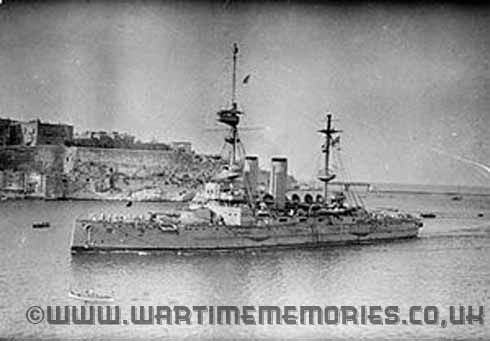
HMS London
HMS London was a pre-dreadnought battleship of the Formidable class. She was laid down at Portsmouth Dockyard on 8th of December 1898, launched on 21st of September 1899, and completed in June 1902.
After the first three Formidables, there was a change in design for the last five ships, starting with London; as a result they are often considered to constitute the London class, but also can be viewed as in effect a sub-class of the Formidable class. The main difference in the Londons was thinner deck armour, some other detail changes to the armour scheme and the consequent lower displacement.
HMS London commissioned at Portsmouth Dockyard on 7th of June 1902 for service in the Mediterranean Fleet. Before departing home waters, she served as flagship for the Coronation Review for King Edward VII at Spithead on 16th of August 1902. While in the Mediterranean, she underwent refits at Malta in 1902,1903 and 1906.
In March 1907, London transferred to the Nore Division, Home Fleet, at the Nore, then to the Channel Fleet on 2nd of June 1908, serving as Flagship, Rear Admiral, Channel Fleet. She underwent a refit at Chatham Dockyard in 1908, and paid off there on 19th of April 1909 to undergo an extensive refit.
Her refit complete, London commissioned at Chatham on 8th of February 1910 to serve as Second Flagship, Rear Admiral, Atlantic Fleet. Under the fleet reorganisation of 1 May 1912, she became part of the Second Home Fleet at the Nore, reduced to a nucleus crew and assigned to the 3rd Battle Squadron. She collided with the merchant steamer SS Don Benite on 11 May 1912. She transferred to the 5th Battle Squadron and was used in experiments with flying off aircraft from May 1912 until 1913, employing a ramp built over her forecastle which had been transferred from the battleship Hibernia. During these experiments, Commander Charles Rumney Samson, who had made the world's first takeoff from a moving ship in May 1912 from Hibernia using a Short Improved S.27 biplane and the same ramp—repeated his feat by taking off in the same aeroplane from London on 4th of July 1912 while London was underway.
Upon the outbreak of World War I in August 1914, the 5th Battle Squadron was assigned to the Channel Fleet and based at Portland. Their first task was to escort the British Expeditionary Force across the English Channel. A number of experimental paint schemes were tried during the first month of the war but these were quickly abandoned in favour of battleship grey.
It was briefly planned to deploy the squadron to replace the ships lost during the Action of 22nd of September 1914 but the orders to transfer to the Medway were rescinded.
The squadron transferred to Sheerness on the 14th of November 1914 to guard against a possible German invasion. While there HMS London was present when HMS Bulwark exploded and London's crew joined in the attempts to rescue survivors. The enquiry into the explosion was carried out aboard HMS London. The squadron returned to Portland on 30th of December 1914.
On the 19th of March 1915, London was transferred for service in the Dardanelles Campaign. She joined the British Dardanelles Squadron at Lemnos on 23rd of March 1915, and supported the main landings at Gaba Tepe and Anzac Cove on 25th of April 1915.
London, along with battleships HMS Implacable, HMS Queen, and HMS Prince of Wales, was transferred to the 2nd Detached Squadron, organised to reinforce the Italian Navy in the Adriatic Sea when Italy declared war on Austria-Hungary. She was based at Taranto, Italy, and underwent a refit at Gibraltar in October 1915 during her Adriatic service. In October 1916, London returned to the United Kingdom, paid off at Devonport Dockyard to provide crews for antisubmarine vessels, and was laid up. While inactive, she underwent a refit in 1916,1917.
In February 1918, London moved to Rosyth and began conversion to a minelayer. The conversion included removal of all four of her 12-inch (305-mm) guns and her anti-torpedo nets, replacement of her after main-battery turret with a 6-inch (152-mm) gun, and installation of minelaying equipment on her quarterdeck, including rails for 240 mines, and of a canvas screen to conceal the entire quarterdeck from external view. The conversion was completed in April 1918, and on 18th of May 1918 London was recommissioned at Rosyth for service in the Grand Fleet's 1st Minelaying Squadron. Before the war ended on 11th of November 1918, London had laid 2,640 mines in the Northern Mine Barrage.
In January 1919, London was reduced to reserve at Devonport as a depot ship. As part of a post-war fleet organisation, she was assigned to the 3rd Fleet there.
London was placed on the disposal list at Devonport in January 1920, and on the sale list on 31st of March 1920. She was sold for scrapping to Stanlee Shipbreaking Company on 4th of June 1920. She was resold to the Slough Trading Company, then again resold to a German firm. She was towed to Germany for scrapping in April 1922.
John Doran
If you can provide any additional information, please add it here.





